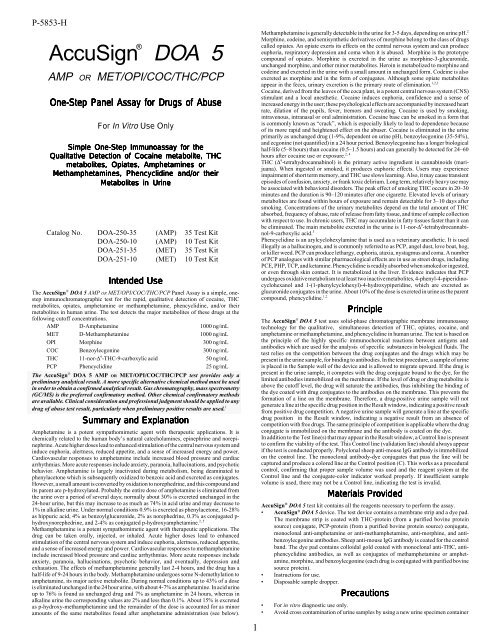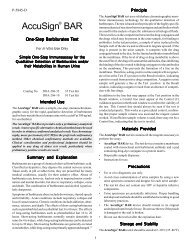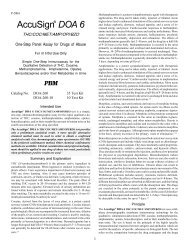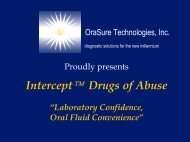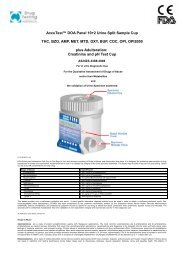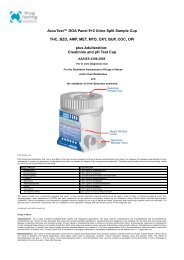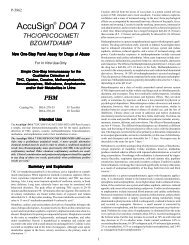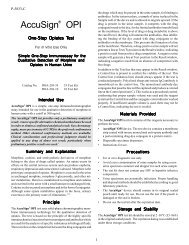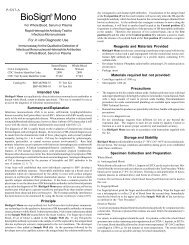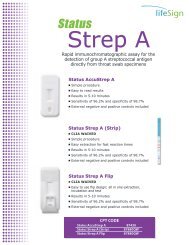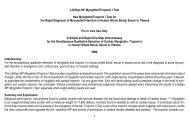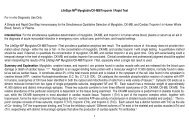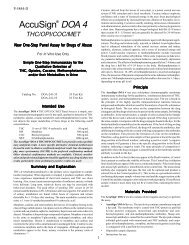AccuSign DOA 5-AMP or MET CE.pdf - Drug Testing
AccuSign DOA 5-AMP or MET CE.pdf - Drug Testing
AccuSign DOA 5-AMP or MET CE.pdf - Drug Testing
Create successful ePaper yourself
Turn your PDF publications into a flip-book with our unique Google optimized e-Paper software.
P-5853-H<br />
<strong>AccuSign</strong> ® <strong>DOA</strong> 5<br />
<strong>AMP</strong> OR <strong>MET</strong>/OPI/COC/THC/PCP<br />
One-Step Panel Assay f<strong>or</strong> <strong>Drug</strong>s of Abuse<br />
F<strong>or</strong> In Vitro Use Only<br />
Simple One-Step Immunoassay f<strong>or</strong> the<br />
Qualitative Detection of Cocaine metabolite, THC<br />
metabolites, Opiates, Amphetamines <strong>or</strong><br />
Methamphetamines, Phencyclidine and/<strong>or</strong> their<br />
Metabolites in Urine<br />
Catalog No. <strong>DOA</strong>-250-35 (<strong>AMP</strong>) 35 Test Kit<br />
<strong>DOA</strong>-250-10 (<strong>AMP</strong>) 10 Test Kit<br />
<strong>DOA</strong>-251-35 (<strong>MET</strong>) 35 Test Kit<br />
<strong>DOA</strong>-251-10 (<strong>MET</strong>) 10 Test Kit<br />
Intended Use<br />
The <strong>AccuSign</strong> ® <strong>DOA</strong> 5 <strong>AMP</strong> OR <strong>MET</strong>/OPI/COC/THC/PCP Panel Assay is a simple, onestep<br />
immunochromatographic test f<strong>or</strong> the rapid, qualitative detection of cocaine, THC<br />
metabolites, opiates, amphetamine <strong>or</strong> methamphetamine, phencyclidine, and/<strong>or</strong> their<br />
metabolites in human urine. The test detects the maj<strong>or</strong> metabolites of these drugs at the<br />
following cutoff concentrations.<br />
<strong>AMP</strong> D-Amphetamine 1000 ng/mL<br />
<strong>MET</strong> D-Methamphetamine 1000 ng/mL<br />
OPI M<strong>or</strong>phine 300 ng/mL<br />
COC Benzoylecgonine 300 ng/mL<br />
THC 11-n<strong>or</strong>-∆ 9 -THC-9-carboxylic acid 50 ng/mL<br />
PCP Phencyclidine 25 ng/mL<br />
The <strong>AccuSign</strong> ® <strong>DOA</strong> 5 <strong>AMP</strong> OR <strong>MET</strong>/OPI/COC/THC/PCP test provides only a<br />
preliminary analytical result. A m<strong>or</strong>e specific alternative chemical method must be used<br />
in <strong>or</strong>der to obtain a confirmed analytical result. Gas chromatography, mass spectrometry<br />
(GC/MS) is the preferred confirmat<strong>or</strong>y method. Other chemical confirmat<strong>or</strong>y methods<br />
are available. Clinical consideration and professional judgment should be applied to any<br />
drug of abuse test result, particularly when preliminary positive results are used. 1<br />
Summary and Explanation<br />
Amphetamine is a potent sympathomimetic agent with therapeutic applications. It is<br />
chemically related to the human body’s natural catecholamines, epinephrine and n<strong>or</strong>epinephrine.<br />
Acute higher doses lead to enhanced stimulation of the central nervous system and<br />
induce euph<strong>or</strong>ia, alertness, reduced appetite, and a sense of increased energy and power.<br />
Cardiovascular responses to amphetamine include increased blood pressure and cardiac<br />
arrhythmias. M<strong>or</strong>e acute responses include anxiety, paranoia, hallucinations, and psychotic<br />
behavi<strong>or</strong>. Amphetamine is largely inactivated during metabolism, being deaminated to<br />
phenylacetone which is subsequently oxidized to benzoic acid and excreted as conjugates.<br />
However, a small amount is converted by oxidation to n<strong>or</strong>ephedrine, and this compound and<br />
its parent are p-hydroxylated. Probably the entire dose of amphetamine is eliminated from<br />
the urine over a period of several days; n<strong>or</strong>mally about 30% is excreted unchanged in the<br />
24-hour urine, but this may increase to as much as 74% in acid urine and may decrease to<br />
1% in alkaline urine. Under n<strong>or</strong>mal conditions 0.9% is excreted as phenylacetone, 16-28%<br />
as hippuric acid, 4% as benzoylglucuronide, 2% as n<strong>or</strong>ephedrine, 0.3% as conjugated p-<br />
hydroxyn<strong>or</strong>ephedrine, and 2-4% as conjugated p-hydroxyamphetamine. 2, 5<br />
Methamphetamine is a potent sympathomimetic agent with therapeutic applications. The<br />
drug can be taken <strong>or</strong>ally, injected, <strong>or</strong> inhaled. Acute higher doses lead to enhanced<br />
stimulation of the central nervous system and induce euph<strong>or</strong>ia, alertness, reduced appetite,<br />
and a sense of increased energy and power. Cardiovascular responses to methamphetamine<br />
include increased blood pressure and cardiac arrhythmias. M<strong>or</strong>e acute responses include<br />
anxiety, paranoia, hallucinations, psychotic behavi<strong>or</strong>, and eventually, depression and<br />
exhaustion. The effects of methamphetamine generally last 2-4 hours, and the drug has a<br />
half-life of 9-24 hours in the body. Methamphetamine undergoes some N-demethylation to<br />
amphetamine, its maj<strong>or</strong> active metabolite. During n<strong>or</strong>mal conditions up to 43% of a dose<br />
is eliminated unchanged in the 24 hour urine, with about 4-7% as amphetamine. In acid urine<br />
up to 76% is found as unchanged drug and 7% as amphetamine in 24 hours, whereas in<br />
alkaline urine the c<strong>or</strong>responding values are 2% and less than 0.1%. About 15% is excreted<br />
as p-hydroxy-methamphetamine and the remainder of the dose is accounted f<strong>or</strong> as min<strong>or</strong><br />
amounts of the same metabolites found after amphetamine administration (see below).<br />
1<br />
Methamphetamine is generally detectable in the urine f<strong>or</strong> 3-5 days, depending on urine pH. 2<br />
M<strong>or</strong>phine, codeine, and semisynthetic derivatives of m<strong>or</strong>phine belong to the class of drugs<br />
called opiates. An opiate exerts its effects on the central nervous system and can produce<br />
euph<strong>or</strong>ia, respirat<strong>or</strong>y depression and coma when it is abused. M<strong>or</strong>phine is the prototype<br />
compound of opiates. M<strong>or</strong>phine is excreted in the urine as m<strong>or</strong>phine-3-glucuronide,<br />
unchanged m<strong>or</strong>phine, and other min<strong>or</strong> metabolites. Heroin is metabolized to m<strong>or</strong>phine and<br />
codeine and excreted in the urine with a small amount in unchanged f<strong>or</strong>m. Codeine is also<br />
excreted as m<strong>or</strong>phine and in the f<strong>or</strong>m of conjugates. Although some opiate metabolites<br />
appear in the feces, urinary excretion is the primary route of elimination. 1,2,3<br />
Cocaine, derived from the leaves of the coca plant, is a potent central nervous system (CNS)<br />
stimulant and a local anesthetic. Cocaine induces euph<strong>or</strong>ia, confidence and a sense of<br />
increased energy in the user; these psychological effects are accompanied by increased heart<br />
rate, dilation of the pupils, fever, trem<strong>or</strong>s and sweating. Cocaine is used by smoking,<br />
intravenous, intranasal <strong>or</strong> <strong>or</strong>al administration. Cocaine base can be smoked in a f<strong>or</strong>m that<br />
is commonly known as “crack”, which is especially likely to lead to dependence because<br />
of its m<strong>or</strong>e rapid and heightened effect on the abuser. Cocaine is eliminated in the urine<br />
primarily as unchanged drug (1-9%, dependent on urine pH), benzoylecgonine (35-54%),<br />
and ecgonine (not quantified) in a 24 hour period. Benzoylecgonine has a longer biological<br />
half-life (5–8 hours) than cocaine (0.5–1.5 hours) and can generally be detected f<strong>or</strong> 24–60<br />
hours after cocaine use <strong>or</strong> exposure. 2, 4<br />
THC (∆ 9 -tetrahydrocannabinol) is the primary active ingredient in cannabinoids (marijuana).<br />
When ingested <strong>or</strong> smoked, it produces euph<strong>or</strong>ic effects. Users may experience<br />
impairment of sh<strong>or</strong>t term mem<strong>or</strong>y, and THC use slows learning. Also, it may cause transient<br />
episodes of confusion, anxiety, <strong>or</strong> frank toxic delirium. Long term, relatively heavy use may<br />
be associated with behavi<strong>or</strong>al dis<strong>or</strong>ders. The peak effect of smoking THC occurs in 20–30<br />
minutes and the duration is 90–120 minutes after one cigarette. Elevated levels of urinary<br />
metabolites are found within hours of exposure and remain detectable f<strong>or</strong> 3–10 days after<br />
smoking. Concentrations of the urinary metabolites depend on the total amount of THC<br />
abs<strong>or</strong>bed, frequency of abuse, rate of release from fatty tissue, and time of sample collection<br />
with respect to use. In chronic users, THC may accumulate in fatty tissues faster than it can<br />
be eliminated. The main metabolite excreted in the urine is 11-n<strong>or</strong>-∆ 9 -tetrahydrocannabinol-9-carboxylic<br />
acid. 3<br />
Phencyclidine is an arylcyclohexylamine that is used as a veterinary anesthetic. It is used<br />
illegally as a hallucinogen, and is commonly referred to as PCP, angel dust, love boat, hog,<br />
<strong>or</strong> killer weed. PCP can produce lethargy, euph<strong>or</strong>ia, ataxia, nystagmus and coma. A number<br />
of PCP analogues with similar pharmacological effects are in use as street drugs, including<br />
P<strong>CE</strong>, PHP, TCP, and ketamine. Phencyclidine is readily abs<strong>or</strong>bed when smoked <strong>or</strong> ingested,<br />
<strong>or</strong> even through skin contact. It is metabolized in the liver. Evidence indicates that PCP<br />
undergoes oxidative metabolism to at least two inactive metabolites, 4-phenyl-4-piperidinocyclohexanol<br />
and 1-(1-phenylcyclohexyl)-4-hydroxypiperidine, which are excreted as<br />
glucuronide conjugates in the urine. About 10% of the dose is excreted in urine as the parent<br />
compound, phencyclidine. 1,2<br />
Principle<br />
The <strong>AccuSign</strong> ® <strong>DOA</strong> 5 test uses solid-phase chromatographic membrane immunoassay<br />
technology f<strong>or</strong> the qualitative, simultaneous detection of THC, opiates, cocaine, and<br />
amphetamine <strong>or</strong> methamphetamine, and phencyclidine in human urine. The test is based on<br />
the principle of the highly specific immunochemical reactions between antigens and<br />
antibodies which are used f<strong>or</strong> the analysis of specific substances in biological fluids. The<br />
test relies on the competition between the drug conjugates and the drugs which may be<br />
present in the urine sample, f<strong>or</strong> binding to antibodies. In the test procedure, a sample of urine<br />
is placed in the Sample well of the device and is allowed to migrate upward. If the drug is<br />
present in the urine sample, it competes with the drug conjugate bound to the dye, f<strong>or</strong> the<br />
limited antibodies immobilized on the membrane. If the level of drug <strong>or</strong> drug metabolite is<br />
above the cutoff level, the drug will saturate the antibodies, thus inhibiting the binding of<br />
the dye coated with drug conjugates to the antibodies on the membrane. This prevents the<br />
f<strong>or</strong>mation of a line on the membrane. Theref<strong>or</strong>e, a drug-positive urine sample will not<br />
generate a line at the specific drug position in the Result window, indicating a positive result<br />
from positive drug competition. A negative urine sample will generate a line at the specific<br />
drug position in the Result window, indicating a negative result from an absence of<br />
competition with free drugs. The same principle of competition is applicable where the drug<br />
conjugate is immobilized on the membrane and the antibody is coated on the dye.<br />
In addition to the Test line(s) that may appear in the Result window, a Control line is present<br />
to confirm the viability of the test. This Control line (validation line) should always appear<br />
if the test is conducted properly. Polyclonal sheep anti-mouse IgG antibody is immobilized<br />
on the control line. The monoclonal antibody-dye conjugates that pass the line will be<br />
captured and produce a col<strong>or</strong>ed line at the Control position (C). This w<strong>or</strong>ks as a procedural<br />
control, confirming that proper sample volume was used and the reagent system at the<br />
Control line and the conjugate-col<strong>or</strong> indicat<strong>or</strong> w<strong>or</strong>ked properly. If insufficient sample<br />
volume is used, there may not be a Control line, indicating the test is invalid.<br />
Materials Provided<br />
<strong>AccuSign</strong> ® <strong>DOA</strong> 5 test kit contains all the reagents necessary to perf<strong>or</strong>m the assay.<br />
• <strong>AccuSign</strong> ® <strong>DOA</strong> 5 device. The test device contains a membrane strip and a dye pad.<br />
The membrane strip is coated with THC-protein (from a purified bovine protein<br />
source) conjugate, PCP-protein (from a purified bovine protein source) conjugate,<br />
monoclonal anti-amphetamine <strong>or</strong> anti-methamphetamine, anti-m<strong>or</strong>phine, and antibenzoylecgonine<br />
antibodies. Sheep anti-mouse IgG antibody is coated f<strong>or</strong> the control<br />
band. The dye pad contains colloidal gold coated with monoclonal anti-THC, antiphencyclidine<br />
antibodies, as well as conjugates of methamphetamine <strong>or</strong> amphetamine,<br />
m<strong>or</strong>phine, and benzoylecgonine (each drug is conjugated with purified bovine<br />
source protein).<br />
• Instructions f<strong>or</strong> use.<br />
• Disposable sample dropper.<br />
Precautions<br />
• F<strong>or</strong> in vitro diagnostic use only.<br />
• Avoid cross contamination of urine samples by using a new urine specimen container
Add 3 drops<br />
(110 µL)<br />
Read in<br />
5–10<br />
minutes<br />
®<br />
<strong>AccuSign</strong><br />
<strong>DOA</strong> 5<br />
Date<br />
ID<br />
C<br />
<strong>AMP</strong><br />
OPI<br />
COC<br />
THC<br />
PCP<br />
Sample<br />
3 drops<br />
No Line = +<br />
Line = –<br />
CONTROL (VALIDATION) LINE (C).<br />
The Control/Validation line indicates:<br />
1. If the proper amount of sample was used;<br />
2. If the sample wicked;<br />
3. If the procedure was followed properly.<br />
If no control line appears, the test is NOT VALID.<br />
Repeat the test using a new device, and follow the<br />
procedure carefully.<br />
C<br />
<strong>AMP</strong><br />
OPI<br />
COC<br />
THC<br />
PCP<br />
(2) (3) (4) (5)<br />
C<br />
C<br />
OR OR OR<br />
<strong>AMP</strong><br />
OPI<br />
COC<br />
THC<br />
PCP<br />
<strong>AMP</strong><br />
OPI<br />
COC<br />
THC<br />
PCP<br />
C<br />
<strong>AMP</strong><br />
OPI<br />
COC<br />
THC<br />
PCP<br />
Sample<br />
3 drops<br />
and dropper f<strong>or</strong> each urine sample.<br />
• This test kit does not contain any HIV <strong>or</strong> hepatitis infective components.<br />
• Urine specimens are potentially infectious. Proper handling and disposal methods<br />
should be followed acc<strong>or</strong>ding to good lab<strong>or</strong>at<strong>or</strong>y practices.<br />
• The <strong>AccuSign</strong> ® device should remain in its <strong>or</strong>iginal sealed pouch until ready f<strong>or</strong> use.<br />
Do not use the test if the pouch is damaged and the seal is broken.<br />
• Do not use the test kit after the expiration date.<br />
St<strong>or</strong>age and Stability<br />
The <strong>AccuSign</strong> ® <strong>DOA</strong> 5 test kit should be st<strong>or</strong>ed at 2–30 ° C (35–86 ° F) in the <strong>or</strong>iginal sealed<br />
pouch. The expiration dating was established under these st<strong>or</strong>age conditions.<br />
Specimen Collection and Preparation<br />
Approximately 110 µL of urine sample is required f<strong>or</strong> each test. Fresh urine specimens do<br />
not require any special handling <strong>or</strong> pretreatment. Specimens should be collected in a clean<br />
glass <strong>or</strong> plastic container. If testing will not be perf<strong>or</strong>med immediately, specimens should be<br />
refrigerated (2–8 ° C) <strong>or</strong> frozen. Specimens should be brought to room temperature bef<strong>or</strong>e<br />
testing.<br />
Specimens containing a large amount of particulate matter may give inconsistent test results.<br />
These specimens should be clarified by centrifuging <strong>or</strong> allowing to settle bef<strong>or</strong>e testing.<br />
Test Procedure<br />
The test procedure consists of adding the urine sample to the Sample well of the device and<br />
watching f<strong>or</strong> the appearance of col<strong>or</strong>ed lines in the Result window.<br />
Test Protocol<br />
C<br />
<strong>AMP</strong><br />
OPI<br />
COC<br />
THC<br />
PCP<br />
No Line = +<br />
Line = –<br />
1. F<strong>or</strong> each test, open one <strong>AccuSign</strong> ® <strong>DOA</strong> 5 pouch and<br />
label the <strong>AccuSign</strong> ® device with the patient ID.<br />
2. Holding the dropper vertically, dispense 3 drops (110 µL)<br />
of the urine sample into the Sample well.<br />
3. Read the result after 5 minutes, but within 10 minutes.<br />
Interpretation of Results<br />
Negative: The appearance of a reddish-purple Control line (C) and a line f<strong>or</strong> a specific<br />
drug indicates a negative test result; i.e., no drug above the cutoff level has been detected.<br />
The col<strong>or</strong> intensities of the Control line and a specific drug line may not be equal. Any faint<br />
line in the Result window, visible in 10 minutes, should be interpreted as negative. A negative<br />
test result does not indicate the absence of drug in the sample; it only indicates the sample<br />
does not contain drug above the cutoff level in qualitative terms.<br />
Positive: The appearance of only a reddish-purple Control line and no distinct line next<br />
to a specific drug name indicates the test result is positive f<strong>or</strong> that drug (i.e., the specimen<br />
contains the drug at a concentration above the cutoff level). A positive test result does not<br />
provide any indication of the level of intoxication <strong>or</strong> urinary concentration of the drug in the<br />
sample; it only indicates the sample contains drug above the cutoff level in qualitative terms.<br />
Invalid: A distinct Control line (C) should always appear. The test is invalid if no Control<br />
line f<strong>or</strong>ms at the C position. Such tests should be repeated with a new <strong>AccuSign</strong> ® <strong>DOA</strong> 5 test<br />
device.<br />
Examples of possible results are shown in the diagram above.<br />
(1) Amphetamines <strong>or</strong> Methamphetamines (–), Opiates (–), Cocaine (–), THC (–),<br />
PCP (–): One Control line at the C position and one each at the THC, OPI, COC, <strong>AMP</strong><br />
<strong>or</strong> <strong>MET</strong> and PCP positions.<br />
ID<br />
Date<br />
®<br />
<strong>AccuSign</strong><br />
<strong>DOA</strong> 5<br />
(1)<br />
2<br />
<strong>AMP</strong> (–)<br />
OPI (–)<br />
COC (–)<br />
THC (+)<br />
PCP (–)<br />
<strong>AMP</strong> (+)<br />
OPI (–)<br />
COC (+)<br />
THC (–)<br />
PCP (–)<br />
Negative (–) = Control line and Specific <strong>Drug</strong> line<br />
Positive (+) = Control line only; No Specific <strong>Drug</strong> line<br />
(2) Amphetamines <strong>or</strong> Methamphetamines (–), Opiates (–), Cocaine (–), THC (+), PCP<br />
(–): One Control line at the C position and one line each at the <strong>AMP</strong> <strong>or</strong> <strong>MET</strong>, OPI, COC<br />
and PCP positions; no line at the THC position.<br />
(3) Amphetamines <strong>or</strong> Methamphetamines (+), Opiates (–), Cocaine (+), THC (–), PCP<br />
(–): One Control line at the C position, one line each at the OPI, THC and PCP positions;<br />
no lines at the <strong>AMP</strong> <strong>or</strong> <strong>MET</strong> and COC positions.<br />
(4) Amphetamines <strong>or</strong> Methamphetamines (–), Opiates (+), Cocaine (–), THC (–), PCP<br />
(+): One Control line at the C position and one line each at the <strong>AMP</strong> <strong>or</strong> <strong>MET</strong>, COC and<br />
THC positions; no line at the OPI and PCP positions.<br />
(5) Invalid: No Control line at the C position.<br />
• There are other possible results, depending on the combinations of drugs present in the<br />
urine sample.<br />
Limitations<br />
<strong>AMP</strong> (–)<br />
OPI (+)<br />
COC (–)<br />
THC (–)<br />
PCP (+)<br />
• The test is designed f<strong>or</strong> use with unadulterated urine only.<br />
• There is a possibility that fact<strong>or</strong>s such as technical <strong>or</strong> procedural err<strong>or</strong>s, as well as other<br />
substances in the urine sample than those listed in Table 3 below, may interfere with the<br />
test and cause erroneous results.<br />
• Adulterants, such as bleach and/<strong>or</strong> alum, in urine specimens may produce erroneous<br />
results. If adulteration is suspected, the test should be repeated with a new sample.<br />
• The test result read after 10 minutes may not be consistent with the <strong>or</strong>iginal reading<br />
obtained within the 10 minute reading period. The test result must be read within 10<br />
minutes of sample application.<br />
• Certain medications containing opiates <strong>or</strong> opiate derivatives <strong>or</strong> amphetamines <strong>or</strong><br />
methamphetamines may produce a positive result. Additionally, foods <strong>or</strong> tea containing<br />
poppy products and/<strong>or</strong> coca leaves may produce a positive result.<br />
User Quality Control<br />
Internal Control: Each <strong>AccuSign</strong> ® <strong>DOA</strong> 5 test device has a built-in control. The Control line<br />
is an internal positive procedural control. A distinct reddish-purple Control line should appear<br />
in the Control position, if the test procedure is perf<strong>or</strong>med properly, an adequate sample volume<br />
is used, the sample and reagent are wicking on the membrane, and the test reagents at the<br />
control line and the conjugate-col<strong>or</strong> indicat<strong>or</strong> are reactive. In addition, if the test is perf<strong>or</strong>med<br />
c<strong>or</strong>rectly and the device is w<strong>or</strong>king properly, the background in the Result window will become<br />
clear and provide a distinct result. This may be considered an internal negative procedural<br />
control.<br />
The positive and negative procedural controls contained in each <strong>AccuSign</strong> ® <strong>DOA</strong> 5 test device<br />
satisfy the requirements of testing a positive control and a negative control on a daily basis. If<br />
the Control line does not appear in the Control position, the test is invalid and a new test should<br />
be perf<strong>or</strong>med. If the problem persists, contact PBM f<strong>or</strong> technical assistance.<br />
External Control: External controls may also be used to assure that the reagents are w<strong>or</strong>king<br />
properly and that the assay procedure is followed c<strong>or</strong>rectly. It is recommended that a control<br />
be tested at regular intervals as good lab<strong>or</strong>at<strong>or</strong>y testing practice. F<strong>or</strong> inf<strong>or</strong>mation on how to<br />
obtain controls, contact PBM’s Technical Services.<br />
Expected Values<br />
<strong>AccuSign</strong> ® <strong>DOA</strong> 5 is a qualitative assay. The amount of drugs and metabolites present in urine<br />
cannot be estimated by the assay. The assay results distinguish positive from negative samples.<br />
Positive results indicate the samples contain the specific drug above the cutoff concentration.<br />
Perf<strong>or</strong>mance Characteristics<br />
INVALID<br />
The <strong>AccuSign</strong> ® <strong>DOA</strong> 5 Panel Assay detects amphetamines <strong>or</strong> methamphetamines, opiates,<br />
cocaine, THC, PCP, and their metabolites at cutoff levels based on the recommendations of<br />
SAMHSA f<strong>or</strong> screening of these drugs in urine. 2 The cutoff level of phencyclidine has been<br />
established ac<strong>or</strong>ding to the mandat<strong>or</strong>y guidelines implemented by the Department of Health
and Human Services f<strong>or</strong> federal w<strong>or</strong>kplace drug testing programs. 3 The following cutoff values are<br />
employed:<br />
<strong>AMP</strong> D-Amphetamine 1000 ng/mL<br />
<strong>MET</strong> D-Methamphetamine 1000 ng/mL<br />
COC Benzoylecgonine 300 ng/mL<br />
THC 11-n<strong>or</strong>-∆ 9 -THC-9-carboxylic acid 50 ng/mL<br />
OPI M<strong>or</strong>phine 300 ng/mL<br />
PCP Phencyclidine 25 ng/mL<br />
The accuracy of <strong>AccuSign</strong> ® <strong>DOA</strong> 5 was evaluated using clinical samples in comparison to two<br />
commercially available immunoassays: Syva ® EMIT ® II f<strong>or</strong> <strong>AMP</strong>/<strong>MET</strong>, OPI, COC and THC; and<br />
Abuscreen ONLINE f<strong>or</strong> PCP (Table 1).<br />
Table 1. Accuracy: Comparison of <strong>AccuSign</strong> ® <strong>DOA</strong> 5 with Syva ® EMIT ® II Assay/Abuscreen<br />
ONLINE<br />
Syva ® EMIT ® II (<strong>AMP</strong>/<strong>MET</strong>, 1000 ng/mL cutoff f<strong>or</strong> both)<br />
Positive Negative TOTAL<br />
<strong>AccuSign</strong> ® Positive 185 0 185<br />
<strong>DOA</strong> 5 (<strong>AMP</strong>) Negative 4 291 295<br />
TOTAL 189 291 480<br />
Overall agreement: 99.2% (476/480). Discrepant samples (4 false-negative samples) were analyzed<br />
by GC/MS and found to contain 1000 to 1250 ng/mL of D-amphetamine, which is within 25% of the<br />
cutoff value.<br />
Syva ® EMIT ® II (<strong>AMP</strong>/<strong>MET</strong>, 1000 ng/mL cutoff f<strong>or</strong> both)<br />
Positive Negative TOTAL<br />
<strong>AccuSign</strong> ® Positive 108 0 108<br />
<strong>DOA</strong> 5 (<strong>MET</strong>) Negative 28 184 212<br />
TOTAL 136 184 320<br />
Overall agreement: 91.3% (292/320). Discrepant samples (28 false-negative samples) were analyzed<br />
by GC/MS and found to contain 1000 to 1250 ng/mL of D-methamphetamine, which is within 25%<br />
of the cutoff value.<br />
Syva ® EMIT ® II (OPI, 300 ng/mL cutoff)<br />
Positive Negative TOTAL<br />
<strong>AccuSign</strong> ® Positive 249 0 249<br />
<strong>DOA</strong> 5 (OPI) Negative 1 716 717<br />
TOTAL 250 716 966<br />
Overall agreement: 99.9% (965/966). The discrepant sample (1 false-negative sample) was analyzed<br />
by GC/MS and found to contain 304 ng/mL of m<strong>or</strong>phine, which is within 25% of the cutoff value.<br />
Syva ® EMIT ® II (COC, 300 ng/mL cutoff)<br />
Positive Negative TOTAL<br />
<strong>AccuSign</strong> ® Positive 369 3 372<br />
<strong>DOA</strong> 5 (COC) Negative 16 635 651<br />
TOTAL 385 638 1023<br />
Overall agreement: 98.1% (1004/1023). Discrepant samples (16 false-negative and 3 false-positive)<br />
were analyzed by GC/MS and found to contain 225 to 375 ng/mL of benzoylecgonine, which is within<br />
25% of the cutoff value.<br />
Syva ® EMIT ® II (THC, 50 ng/mL cutoff)<br />
Positive Negative TOTAL<br />
<strong>AccuSign</strong> ® Positive 327 5 332<br />
<strong>DOA</strong> 5 (THC) Negative 13 6655 668<br />
TOTAL 340 660 1000<br />
Overall agreement: 98.2% (982/1000). Discrepant samples (13 false-negative and 5 false-positive<br />
samples) were analyzed by GC/MS and found to contain 35 to 65 ng/mL of 11-n<strong>or</strong>-∆ 9 -THC-9-<br />
carboxylic acid, which is within 30% of the cutoff value.<br />
Abuscreen ONLINE (PCP, 25 ng/mL cutoff)<br />
Positive Negative TOTAL<br />
<strong>AccuSign</strong> ® Positive 53 0 53<br />
<strong>DOA</strong> 5 (PCP) Negative 2 102 104<br />
TOTAL 55 102 157<br />
Overall agreement: 98.7% (155/157). Discrepant samples (2 false-negative samples) were analyzed<br />
by GC/MS and found to contain 27 and 28 ng/mL of phencyclidine, which is within 25% of the cutoff<br />
value.<br />
Relative Sensitivity<br />
Relative Specificity<br />
Amphetamine 97.9% (185/189) > 99.9% (291/291)<br />
Methamphetamine 79.4% (108/136) > 99.9% (184/184)<br />
Opiates 99.6% (249/250) > 99.9% (716/716)<br />
Cocaine 95.8% (369/385) 99.5% (635/638)<br />
THC 96.2% (327/340) 99.2% (655/660)<br />
Phencyclidine 96.4% (53/55) > 99.9% (102/102)<br />
3<br />
In a separate study, <strong>AccuSign</strong> ® <strong>DOA</strong> 5 was evaluated against specimens confirmed as<br />
positive by GC/MS, f<strong>or</strong> each drug. The results below demonstrate the excellent c<strong>or</strong>relation<br />
of <strong>AccuSign</strong> ® <strong>DOA</strong> 5 with GC/MS (99% agreement). All specimens examined by GC/MS<br />
were clinical samples except f<strong>or</strong> PCP, in which 6 out of 21 were clinical samples and 15<br />
samples were prepared by dilution of a high positive clinical sample with negative urine<br />
control (Table 2).<br />
Table 2. Accuracy: Comparison of <strong>AccuSign</strong> ® <strong>DOA</strong> 5 with GC/MS Assay<br />
Concentration <strong>AccuSign</strong> ® GC/MS<br />
Range (ng/mL)<br />
<strong>AMP</strong> Positive 1010–1544 55 56<br />
Negative 1 0<br />
<strong>MET</strong> Positive 1006–1489 88 89<br />
Negative 1 0<br />
OPI Positive 302–566 73 74<br />
Negative 1 0<br />
COC Positive 304–607 77 78<br />
Negative 1 0<br />
THC Positive 52-78 87 88<br />
Negative 1 0<br />
PCP Positive 27–50 21 21<br />
Negative 0 0<br />
Precision and Accuracy<br />
The precision of the <strong>AccuSign</strong> ® <strong>DOA</strong> 5 Panel Assay was determined by carrying out the test<br />
with serially diluted standard drug solutions using three lots of product on three different<br />
days with three different operat<strong>or</strong>s. Each diluted drug sample was tested in 15 replicates f<strong>or</strong><br />
each lot. About 98% of the samples containing benzoylecgonine, opiates, amphetamine <strong>or</strong><br />
methamphetamine, and phencyclidine and about 91% of the samples containing 11-n<strong>or</strong>-∆ 9 -<br />
THC-9-COOH concentrations 25% over the cutoff level consistently showed positive<br />
results.<br />
Distribution of Random Err<strong>or</strong>:<br />
Twenty (20) blind samples prepared by spiking four (4) different concentrations (0, 50% of<br />
cutoff, 150% of cutoff, and 200% of cutoff) of 11-n<strong>or</strong>-Ð 9 -THC-9-COOH, benzoylecgonine,<br />
m<strong>or</strong>phine, amphetamine <strong>or</strong> methamphetamine, and phencyclidine were separately tested by<br />
two operat<strong>or</strong>s. The test results f<strong>or</strong> each drug from the two operat<strong>or</strong>s showed complete<br />
agreement.<br />
Reproducibility<br />
The reproducibility of the <strong>AccuSign</strong> ® <strong>DOA</strong> 5 Panel Assay test results was examined at three<br />
different sites using a total of 55 blind controls, consisting of 5 negative samples, 5<br />
moderately positive samples, and 5 strongly positive samples f<strong>or</strong> each drug. The moderately<br />
positive samples contained 200% of the cutoff level and the strongly positive samples<br />
contained 400% of the cutoff level of the respective drug. The results obtained at these three<br />
sites with these controls demonstrated 100% agreement with each other.<br />
Specificity<br />
The following table lists compounds that are detected by the <strong>AccuSign</strong> ® <strong>DOA</strong> 5 <strong>AMP</strong> OR<br />
<strong>MET</strong>/OPI/COC/THC/PCP test. The specificity of the <strong>AccuSign</strong> ® <strong>DOA</strong> 5 test was<br />
determined by adding various drugs and drug metabolites to drug-negative urine specimens<br />
and testing with the <strong>AccuSign</strong> ® <strong>DOA</strong> 5 test kit. The results are expressed in terms of the<br />
approximate minimum concentration required to produce a result equivalent to the result at<br />
the assay cutoff f<strong>or</strong> each drug. Approximate percent cross-reactivity was calculated by<br />
dividing the cutoff value of each drug by the concentration and multiplying by 100% (Table<br />
3).<br />
Table 3. Specificity<br />
Concentration % Cross-<br />
Compound (ng/mL) reactivity<br />
<strong>AMP</strong><br />
D-Amphetamine 1,000 100<br />
D,L-Amphetamine 1,500 67<br />
L-Amphetamine 60,000 1.7<br />
Methylenedioxyamphetamine<br />
700 143<br />
ß-Phenethylamine 60,000 1.7<br />
Phentermine 350 286<br />
Tryptamine 50,000 2<br />
Tyramine 70,000 1.4<br />
<strong>MET</strong><br />
D-Amphetamine 200,000 0.5<br />
D,L-Amphetamine >200,000<br />
(–)Ephedrine 200,000 0.5<br />
(+)Ephedrine 200,000 0.5<br />
D-Methamphetamine 1,000 100<br />
p-OH-Methamphetamine >200,000<br />
Methylenedioxyamphetamine >200,000<br />
Methylenedioxymethamphetamine 2,000 50<br />
OPI<br />
Codeine 300 100<br />
Hydrocodone 500 60<br />
Hydrom<strong>or</strong>phone 600 50<br />
Lev<strong>or</strong>phanol 5,000 6<br />
Meperidine 80,000 0.4
M<strong>or</strong>phine 300 100<br />
M<strong>or</strong>phine-3-ß-D-glucuronide 500 60<br />
Nal<strong>or</strong>phine 1,000 30<br />
Naloxane 100,000 0.3<br />
N<strong>or</strong>codeine 60,000 0.5<br />
Oxycodone 20,000 1.5<br />
Oxym<strong>or</strong>phone 60,000 0.5<br />
Procaine HCl 100,000 0.3<br />
Thebaine 5,000 6<br />
COC<br />
Benzoylecgonine 300 100<br />
Cocaine HCl >100,000<br />
Ecgonine HCl 50,000 0.6<br />
THC<br />
Cannabinol 50,000 0.1<br />
11-n<strong>or</strong>-∆ 8 -THC-9-COOH 250 20<br />
11-n<strong>or</strong>-∆ 9 -THC-9-COOH 50 100<br />
∆ 8 -THC 25,000 0.2<br />
∆ 9 -THC 15,000 0.3<br />
11-hydroxy-∆ 9 -THC 10,000 0.5<br />
PCP<br />
Phencyclidine 25 100<br />
Thienylcyclohexylpiperidine 2500 1<br />
Cross-reactivity with endogenous compounds:<br />
The following compounds show no cross-reactivity when tested with <strong>AccuSign</strong> ® <strong>DOA</strong> 5 at<br />
a concentration of 100 µg/mL. The compounds were spiked into the negative and positive<br />
urine controls containing the cutoff concentration of each drug (Table 4).<br />
Table 4. Non Cross-Reacting Endogenous Compounds<br />
Acetaldehyde<br />
Acetone<br />
Albumin<br />
Bilirubin<br />
Cholesterol<br />
Creatinine<br />
Dopamine<br />
Epinephrine<br />
ß-Estradiol<br />
Estriol<br />
Glucose<br />
Hemoglobin<br />
Ketones<br />
Sodium chl<strong>or</strong>ide<br />
Tetrahydroc<strong>or</strong>tisone<br />
D,L-Thyroxine<br />
Uric acid<br />
Cross-reactivity with unrelated compounds:<br />
The following compounds show no cross-reactivity when tested with <strong>AccuSign</strong> ® <strong>DOA</strong> 5 at<br />
a concentration of 100 µg/mL. The compounds were spiked into the negative and positive<br />
urine controls containing the cutoff concentration of each drug (Table 5).<br />
Table 5. Non Cross-Reacting Unrelated Compounds<br />
4-Acetamidophenol<br />
Acetaminophen<br />
Acetophenetidin (Phenacetin)<br />
N-Acetylprocainamide<br />
Acetylsalicylic acid<br />
Aminopyrine<br />
Amitriptyline<br />
Amobarbital<br />
Amoxapine<br />
Amoxicillin<br />
Ampicillin<br />
Apom<strong>or</strong>phine<br />
Asc<strong>or</strong>bic acid<br />
Aspartame<br />
Atropine<br />
Benzilic acid<br />
Benzoic acid<br />
Benzocaine<br />
Benzphetamine<br />
Butabarbital<br />
Caffeine<br />
Calcium hypochl<strong>or</strong>ide<br />
Chl<strong>or</strong>alhydrate<br />
Chl<strong>or</strong>amphenicol<br />
Chl<strong>or</strong>diazepoxide<br />
Chl<strong>or</strong>othiazide<br />
Chl<strong>or</strong>pheniramine<br />
Chl<strong>or</strong>promazine<br />
Chl<strong>or</strong>oquine<br />
Clomipramine<br />
Clonidine<br />
C<strong>or</strong>tisone<br />
(–) Cotinine<br />
Deoxyc<strong>or</strong>ticosterone<br />
Dextrometh<strong>or</strong>phan<br />
Dextropropoxyphene<br />
Diazepam<br />
Diclofenac<br />
Diethylpropion<br />
Diflunisal<br />
Digoxin<br />
Diphenhydramine<br />
Diphenylhydantoin<br />
Domperidone<br />
Doxylamine<br />
Epinephrine<br />
Erythromycin<br />
Estrone-3-sulfate<br />
Ethyl-p-aminobenzoate<br />
Fenoprofen<br />
Furoxmide<br />
Gentisic acid<br />
Glutethimide<br />
Guaiacol glycerol ether<br />
Guaifenesin<br />
Hippuric acid<br />
Hydralazine<br />
Hydrochl<strong>or</strong>othiazide<br />
Hydroc<strong>or</strong>tisone<br />
O-Hydroxyhippuric acid<br />
Ibuprofen<br />
Imipramine<br />
Iproniazid<br />
(–) Isoproterenol<br />
Isoxsuprine<br />
Ketamine<br />
Ketoprofen<br />
Labetalol<br />
Lidocaine<br />
Loperamide<br />
Loxapine succinate<br />
Lysergic acid diethylamide<br />
Maprotiline<br />
Melanin<br />
Meprobamate<br />
Methadone<br />
Methaqualone<br />
Methylphenidate<br />
Methyoxyphenamine<br />
Methyprylon<br />
Nalidixic acid<br />
Naltrexone<br />
Naproxen<br />
Niacinamide<br />
Nifedipine<br />
N<strong>or</strong>ethindrone<br />
D-N<strong>or</strong>propoxyphene<br />
(–) N<strong>or</strong>pseudoephedrine<br />
Noscapine<br />
Nylidrin<br />
D,L-Octopamine<br />
Oxalic acid<br />
Oxazepam<br />
Oxolinic acid<br />
Oxymetazoline<br />
Papaverine<br />
Penicillin-G<br />
Pentazocaine<br />
Pentobarbital<br />
Perphenazine<br />
Phendimetrazine<br />
Phenelzine<br />
Phenobarbital<br />
Phenothiazine<br />
Phentoin<br />
Phenylbutazone<br />
L-Phenylephrine<br />
Phenylbutazone<br />
D,L-Phenylpropanolamine<br />
D-Phenylpropanolamine<br />
Prednisolone<br />
Prednisone<br />
Promazine<br />
Promethazine<br />
D,L-Propanolol<br />
Propiomazine<br />
D-Propoxyphene<br />
D-Pseudoephedrine<br />
L-Pseudoephedrine<br />
Quinidine<br />
Quinine<br />
Rantidine<br />
Salicylic acid<br />
Secobarbital<br />
References<br />
Serotonin<br />
Sulfamethazine<br />
Sulindac<br />
Temazepam<br />
Tetracycline<br />
Tetrahydrozoline<br />
Thiamine<br />
Thi<strong>or</strong>idazine<br />
Tolbutamide<br />
Triamterene<br />
Trifluoperazine<br />
Trimethoprim<br />
Trimipramine<br />
D,L-Tryptophan<br />
D,L-Tyrosine<br />
Verapamil<br />
Zomepirac<br />
1. Hawks RL, Chiang CN, eds. Urine <strong>Testing</strong> f<strong>or</strong> <strong>Drug</strong>s of Abuse. National Institute on<br />
<strong>Drug</strong> Abuse (NIDA), Research Monograph 73; 1986.<br />
2. Baselt RC. Disposition of Toxic <strong>Drug</strong>s and Chemicals in Man. 2nd Ed., Davis, CA:<br />
Biomedical Publ.; 1982; p.488.<br />
3. Tietz, N<strong>or</strong>bert W. Textbook of Clinical Chemistry. W.B. Saunders Company. 1986, p.<br />
1735.<br />
4. Ambre J. J. Anal. Toxicol. 1985;9:241–5.<br />
5. Blum K. Handbook of Abusable <strong>Drug</strong>s. 1st ed. New Y<strong>or</strong>k: Gardner Press, Inc.; 1984.<br />
Manufactured by<br />
<strong>CE</strong> Mark<br />
Symbols Key<br />
Auth<strong>or</strong>ized Representative<br />
In Vitro Diagnostic Medical Device<br />
Catalog Number<br />
Consult Instructions f<strong>or</strong> Use<br />
Batch Code<br />
“Use By” date in year-month-day f<strong>or</strong>mat<br />
Temperature Limitation<br />
Contains sufficient f<strong>or</strong> tests<br />
Do not reuse<br />
Contents<br />
Test Device<br />
Transfer Pipette<br />
Instructions f<strong>or</strong> Use<br />
One-step Immunochromatographic Assay f<strong>or</strong><br />
the Detection of <strong>Drug</strong>s of Abuse in Urine<br />
Amphetamine/Opiates/Cocaine/<br />
Marijuana/Phencyclidine Test<br />
Methamphetamine/Opiates/Cocaine/<br />
Marijuana/Phencyclidine Test<br />
<strong>AccuSign</strong> ® is a Registered Trademark of Princeton BioMeditech C<strong>or</strong>p<strong>or</strong>ation.<br />
Manufactured by<br />
Patent No.: 5,559,041<br />
© 2000 PBM<br />
Printed in U.S.A.<br />
Revised Oct 2003<br />
P-5853-H 1013BL<br />
4<br />
MT Promedt Consulting GmbH<br />
Eisenbahnstrasse 2<br />
D-66386 St. Ingbert<br />
Germany<br />
+49-68 94-58 10 20<br />
Princeton BioMeditech C<strong>or</strong>p<strong>or</strong>ation<br />
Princeton, NJ 08543-7139 U.S.A.<br />
1-732-274–1000 www.pbmc.com


